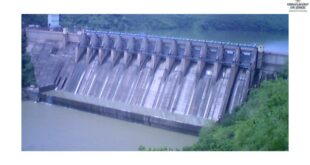In spite of the receding flood following let-up in rains in their catchment areas, the water levels in the Krishna and its tributaries Bhima and Tungabhdra continue to be high keeping people in the villages along the course of rivers and the district administration on their toes.With about 7.45 lakh cusecs inflows into Jurala from Krishna and Bhima rivers, five villages in Narayanpet (4)and Jogulamba-Gadwal (1) districts remain inundated. Over 1,000 families have been shifted from these villages to relief camps. Damage caused to installations such as electrical sub-stations, drinking water schemes, roads and standing crops and others due to inundation was being assessed. “There is no further threat of evacuation in the villages along both Krishna and Tungabhadra rivers. The personnel of two NDRF teams are going around vulnerable villages creating awareness among people and the water is receding from fields and from the inundated village Nagardoddi. The damage left behind by the flood, mostly to crops, would be assessed soon and reported to the government”, District Collector of Jogulamba-Gadwal K. Shashanka explained when contacted on Tuesday.
In Narayanpet district, the administration has estimated crops damage in about 4,200 acres so far and assessed the loss at about Rs. 42 lakh in addition to Rs. 1.1 crore damage to other installations. “We are providing maximum possible comfort to families given shelter in the relief camps by stationing medical teams there, providing television connection and organising cultural programmes”, District Collector S. Venkata Rao said. Water in the inundated villages is receding and people would start returning to their homes over the next couple of days.
At Tungabhadra dam near Hospet in Karantaka, the inflows were recorded at 1.36 lakh cusecs and the outflows at 1.16 lakh cusecs including 1.10 lakh cusecs to the river course at 7 pm on Tuesday. With the help of higher quantity flood released earlier, the inflows at Sunkesula barrage were at over 1.74 lakh cusecs and discharge at 1.67 lakh cusecs to the river course at 8 pm.Similarly, the inflows into Almatti were recorded at 6.05 lakh cusecs and outflows at 5.7 lakh cusecs at 6 pm. At Narayanpur, inflows were at 6 lakh cusecs and outflows at 5.95 lakh cusecs. At Jurala, the inflows were 7.45 lakh cusecs and outflows were 7.32 lakh cusecs including 7.26 lakh cusecs into the river course from 56 spillway gates.
At Srisailam, inflows were at 8.83 lakh cusecs and outflows were 8.84 lakh cusecs including 7.81 lakh cusecs to the river course through 10 spillway gates lifted for 42 feet height each and another 72,000 cusecs after power generation. At Nagarjunasagar, inflows were 8.15 lakh cusecs and outflows over 5.36 lakh cusecs through the spillway and canals.
Check Also
Heat waves in Mediterranean Sea
Salient features of world’s physical geography. Extreme heat has plagued the Mediterranean for weeks. What …
 Chinmaya IAS Academy – Current Affairs Chinmaya IAS Academy – Current Affairs
Chinmaya IAS Academy – Current Affairs Chinmaya IAS Academy – Current Affairs

